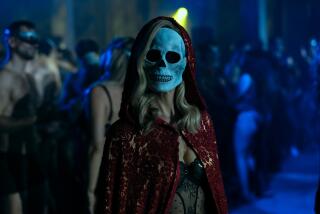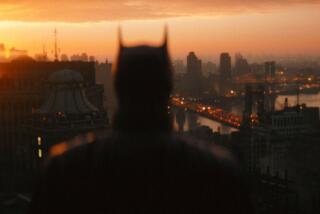Holy Flying Fur, Bat Woman! : Bitten by Love for These Maligned Mammals, She’s on a Mission to Clean Up Their Image as Evil Blood-Suckers
To Lynn Barkley, the music of the night is the buzzing of bats.
She has tracked them from Latin America to Thailand, side-step ping venomous snakes a la Indi ana Jones and coming face-to-face with killer bees.
Currently, she is bat expert in residence for “Masters of the Night: The True Story of Bats” at the Museum of Natural History’s Burbank site through Jan. 16.
With infant son Matthew in her arms, Barkley leads the way through the darkened rooms, stopping to admire a lifelike model of a fishing bat. “A neat, neat bat,” she says. “The fur feels like indoor-outdoor carpet.”
Matthew seems transfixed by a repeating video of little-known bat facts. Barkley observes that Batmania (as in the movies and TV series reruns) has made bats more user-friendly. “Kids aren’t as scared of them as their parents were.”
That’s all very well, but What about those blood-sucking Halloween bats!? They aren’t exactly known for their warmth and fuzziness. . .
Don’t believe all the hype, Barkley says. Of 1,000 species of bats worldwide, there are only three kinds of vampire bats, all in Latin America, where she’s netted her share.
True, the vampire has to have blood. When caught, “They usually have this belly-full of blood and they’ve got blood all over their mouths.”
(Generous to a fault, they will regurgitate blood to share with other bats).
And yes, it’s true that the vampire’s weapons include razor-sharp teeth and two-digit opposable thumbs that enable it to land near its prey, walk over and pounce. But horror stories to the contrary, vampires can’t suck blood. “They lap it up,” Barkley explains.
Bad manners, yes, but great scientific possibilities. “They have this anticoagulant in their saliva that has incredible potential as a heart medication.”
Barkley, 37, became a bat woman inadvertently. While at Louisiana Tech, she joined ornithologist friends on a bat study in Arkansas.
“I had a Fulbright to Scotland to study sea birds for my master’s,” she recalls. Instead, she went on to Peru with her friends and got hooked on bats. While hanging out with bats, she took time off to earn a master’s in zoology at LSU.
In her pursuits, she has had bats in her hair and has crawled through the foulest slush. Once, in Peru, she and a companion were trapped in a cave by a swarm of Africanized “killer bees” that killed their horse and mule. Barkley was bitten four times, her head swelling to twice its normal size.
She collects vital organs and innards, hair, muscles, skeletons and bone marrow, which yield clues about preservation of species, as well as the role of bats as pollinators in saving rain forests and of bats, as bug-eaters, in the agricultural economy.
This is research, not sport. Barkley is adamant: “If you sacrifice an animal, you use it all.”
Officially, Barkley is collections manager, mammals section, L.A. County Museum of Natural History. She also makes comforting house calls on Southern Californians panicked by bat invasions by giving advice on how to live with bats.
Now, a few Barkley bat facts:
* Bats are gentle. Some are “highly gregarious” and like to be petted.
* Bats are not related to rodents. Probably, Barkley thinks, they are descended from “some strange insectivore.”
* Bats live to be old bats, commonly 20-30 years.
* To catch a bat, you string up a black “mist” net and wait for the bats to get entangled.
* Bats do not mate for life, but observe certain social conventions. Says Barkley, “Most females, when pregnant, will go off and roost with other pregnant females. You’ll have bachelor colonies and maternity colonies and nursing colonies.”
Some are endangered, among them an Eastern cave dweller that hibernates. “Thousands have been killed, inadvertently, by people waking them up and getting their metabolism started.” That left them without enough energy reserves to survive winter.
Except for rare twins, a bat produces only one offspring a year. At term, the bat-to-be is half the size of mom. “Imagine,” Barkley suggests, “a 120-pound woman with a 60-pound (newborn), flying around and catching her meals. . .”
Bats also get eaten, by humans and by other bats. And pesticides are a threat. On the other hand, Barkley notes, one reason they’ve been around for 50 million years is that “they’re filling a niche that there’s not a whole lot of competition for,” flying around at night gulping insects.
So, when you think bat, think gentle, kind. Only a fraction of bats are rabid, Barkley says, and only a few “could really bite you where you’d feel it.” She’s been bitten twice, by netted bats. (She immunized against rabies.)
Why do bats get a bad rap?
Says Barkley: “We’re scared of things we don’t know a lot about and things that do things we don’t do.”
Somehow, Clem Just Isn’t as Scary
Well, Franckenstein has selected his Halloween costume. This year, he’s going as Dracula.
He’ll don a tux, paint black circles around his eyes, slick back his hair and play cricket in the Hollywood Hills with a group of fellow actors and fellow expatriate Brits.
“Instead of wearing white, we’re all wearing black,” explains Baron Clement von Franckenstein.
Truth is, he isn’t really up for dressing up. The Eton-educated baron just finished playing a 50-foot alien in a giant-screen Imax film, “The Journey Inside”: “It took me four hours to get made up every day.”
Besides, he’s never hankered to be a Halloween Frankenstein--”I’d have to wear this mask, and it gets very hot.”
Franckenstein, (Clem to his friends), is son of Baron George von Franckenstein--onetime Austrian ambassador to the Court of St. James--and his English wife.
And he’s been told that Mary Shelley saw a newspaper story about the Franckensteins--whose noble lineage goes back to 801 --and took the name for her horror story.
But, a title and a few dollars will buy you a shot of schnapps. So when Hollywood first beckoned, Von Franckenstein, now 49, jumped at the chance to be Henry VIII in a Medieval-theme restaurant in Anaheim: “We sang bawdy English ballads while lots of wenches were running around serving mead.”
Briefly, he changed his name to Clement St. George, but finds he’s doing better as Franckenstein redux. He’s in Mel Brooks’ “Men in Tights” and plays--what else?--a mad scientist in a Life Savers commercial.
More to Read
The biggest entertainment stories
Get our big stories about Hollywood, film, television, music, arts, culture and more right in your inbox as soon as they publish.
You may occasionally receive promotional content from the Los Angeles Times.










